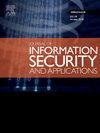Adaptive security framework for multi-environment networks using ensemble data drift detection and incremental deep learning
IF 3.7
2区 计算机科学
Q2 COMPUTER SCIENCE, INFORMATION SYSTEMS
Journal of Information Security and Applications
Pub Date : 2025-09-12
DOI:10.1016/j.jisa.2025.104219
引用次数: 0
Abstract
Modern multi-environment (M-En) networks comprise diverse architectures such as IoT and traditional IP-based networks. These networks pose significant challenges for threat mitigation due to heterogeneous protocols and traffic patterns. This study proposes a unified incremental learning framework to efficiently secure M-En networks by reducing management overhead, improving scalability, and lowering costs. We designed this approach for real-time environments, enabling adaptation to new scenarios with high accuracy and efficiency. To develop the framework, we first generate an M-En dataset using partial least squares canonical analysis, synthesizing data from two benchmark datasets: IoT23 and CICDDoS2019, representing IoT and traditional IP-based networks, respectively. Our approach employs an ensemble data drift detection (EDDD) mechanism that combines ADaptive WINdowing and autoencoders, enabling adaptive model updates. A deep neural network is incrementally retrained only when data drift is detected, ensuring adaptability to evolving attacks while conserving computational resources. To avoid catastrophic forgetting, we incorporate replay-based memory, regularization, and an interpolation mechanism governed by a blending parameter , which balances the integration of new and historical knowledge. Furthermore, the explainable AI technique LIME is integrated to enhance the transparency of the model’s decision-making process. Experimental results indicate that our approach achieves a mean accuracy of 0.999 while maintaining low memory usage, approximately 32.1 MB, and a stable model size of 0.11 MB.
基于集成数据漂移检测和增量深度学习的多环境网络自适应安全框架
现代多环境(M-En)网络包括物联网和传统基于ip的网络等多种架构。由于异构协议和流量模式,这些网络对缓解威胁构成了重大挑战。本研究提出了一个统一的增量学习框架,通过减少管理开销,提高可扩展性和降低成本来有效地保护M-En网络。我们为实时环境设计了这种方法,能够以高精度和高效率适应新的场景。为了开发该框架,我们首先使用偏最小二乘典型分析生成M-En数据集,综合来自两个基准数据集的数据:IoT23和CICDDoS2019,分别代表物联网和传统的基于ip的网络。我们的方法采用集成数据漂移检测(EDDD)机制,该机制结合了自适应窗口和自动编码器,实现了自适应模型更新。深度神经网络仅在检测到数据漂移时才进行增量再训练,以确保对不断变化的攻击的适应性,同时节省计算资源。为了避免灾难性遗忘,我们结合了基于重播的记忆、正则化和由混合参数α∈[0,1]控制的插值机制,以平衡新知识和历史知识的整合。此外,还集成了可解释人工智能技术LIME,以提高模型决策过程的透明度。实验结果表明,我们的方法在保持低内存使用(约32.1 MB)和稳定的模型大小(0.11 MB)的情况下,平均准确率达到0.999。
本文章由计算机程序翻译,如有差异,请以英文原文为准。
求助全文
约1分钟内获得全文
求助全文
来源期刊

Journal of Information Security and Applications
Computer Science-Computer Networks and Communications
CiteScore
10.90
自引率
5.40%
发文量
206
审稿时长
56 days
期刊介绍:
Journal of Information Security and Applications (JISA) focuses on the original research and practice-driven applications with relevance to information security and applications. JISA provides a common linkage between a vibrant scientific and research community and industry professionals by offering a clear view on modern problems and challenges in information security, as well as identifying promising scientific and "best-practice" solutions. JISA issues offer a balance between original research work and innovative industrial approaches by internationally renowned information security experts and researchers.
 求助内容:
求助内容: 应助结果提醒方式:
应助结果提醒方式:


